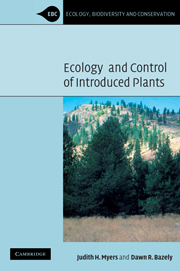Book contents
- Frontmatter
- Contents
- Preface
- 1 Introduction
- 2 Planet of Weeds: exotic plants in the landscape
- 3 Biological invasions in the context of plant communities
- 4 Predicting invasiveness from life history characteristics
- 5 Population ecology and introduced plants
- 6 Introduced plant diseases
- 7 Biological control of introduced plants
- 8 Modeling invasive plants and their control
- 9 Action against non-indigenous species
- 10 Genetically modified plants and final conclusions
- Appendix
- References
- Index
10 - Genetically modified plants and final conclusions
Published online by Cambridge University Press: 02 December 2009
- Frontmatter
- Contents
- Preface
- 1 Introduction
- 2 Planet of Weeds: exotic plants in the landscape
- 3 Biological invasions in the context of plant communities
- 4 Predicting invasiveness from life history characteristics
- 5 Population ecology and introduced plants
- 6 Introduced plant diseases
- 7 Biological control of introduced plants
- 8 Modeling invasive plants and their control
- 9 Action against non-indigenous species
- 10 Genetically modified plants and final conclusions
- Appendix
- References
- Index
Summary
Genetically modified plants: another time bomb?
In Chapter 1 we described what Naylor (2000) calls a time bomb. This is the prolonged period of low density observed for many species before they begin to rapidly increase (Figures 1.2 and 2.8). The situation with genetically modified plants may represent another invasion time bomb. The production and release into uncontrolled environments of genetically modified crop plants (GMOs) is another frontier for invasion ecology. It might be that modification of plants could increase their invasiveness and therefore produce super weeds. More likely is the invasion of genetic material into new continents or into natural ecosystems. The fundamental assumption underlying the technology of genetic modification, is that genes from other organisms, introduced by bacteria to target plant species, will direct the production of (useful) proteins that are not normally synthesized by that plant. Currently little peer-reviewed research exists about the impacts of releasing these essentially non-native organisms into the environment. One reason for this is that it is difficult to obtain modified plants from their industrial creators, prior to their release onto the agricultural market. Once the GMOs have been released, research is more feasible, but it may then be too late to act if problems are revealed.
Many agriculture crops have close relatives among native plants. For example squash, Cucurbita pepo, has been modified through transgenes to be resistant to viral disease. This species occurs outside cultivation, and interbreeds with native subspecies (Parker and Kareiva 1996).
- Type
- Chapter
- Information
- Ecology and Control of Introduced Plants , pp. 244 - 250Publisher: Cambridge University PressPrint publication year: 2003

